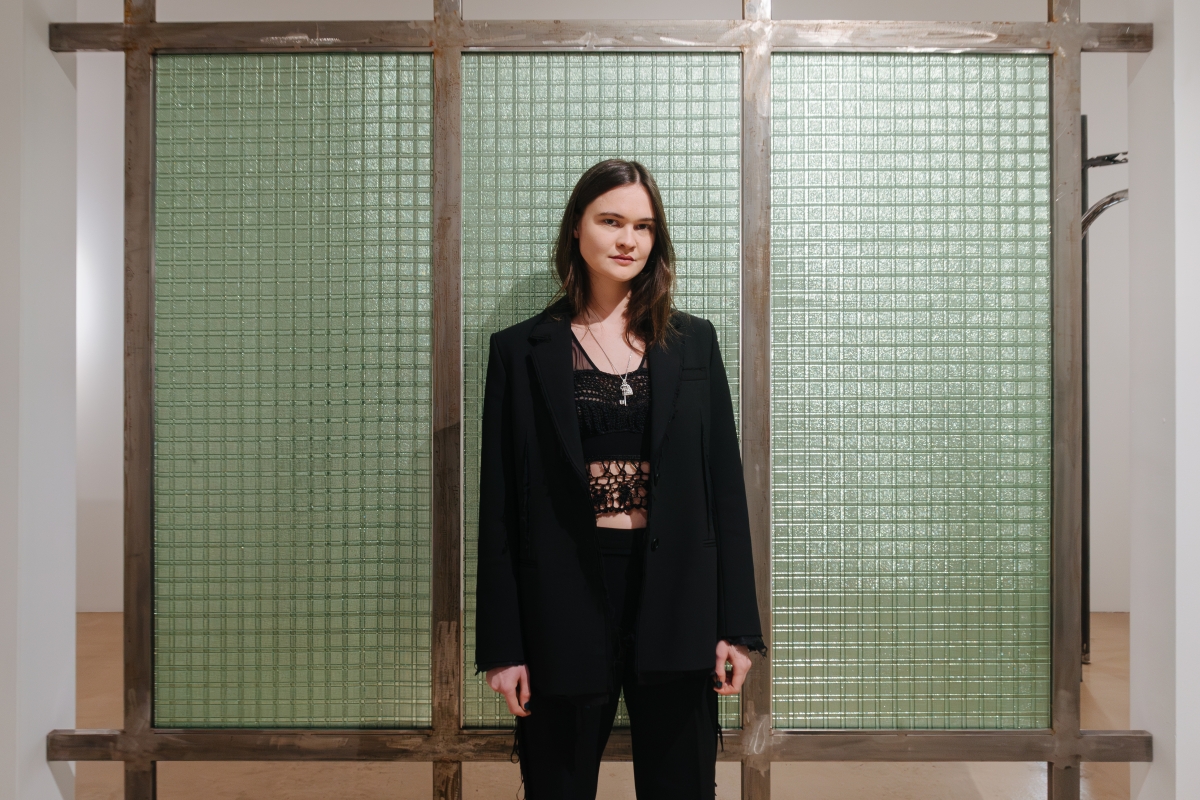The up-and-coming Latvian artist Karlīna Mežecka is based in London, where she made a mark with new techniques following her graduation from the Royal College of Art’s Ceramics and Glass Department in 2022. Mežecka’s artistic practice centres around ceramics, but her signature style lies in the skill of seamlessly blurring the boundaries of different surface qualities and transforming them into a cohesive whole. This includes different glazes that mimic the qualities of metal, as well as incorporating steel and showcasing a marriage of glass and ceramics, forming distinctly delicate alliances. Through her exploration of materials, Karlīna Mežecka disrupts the tranquil cadence of the time-honoured craft, leaving tradition in her creative wake.
In her debut solo exhibition ‘Archive of Fragility’ at the Kim? Contemporary Art Centre, the artist delves into the poetics of regional space and human emotional experience within it. The exhibition reflects on the themes of fragility, inspired by the artist’s exploration of materiality. A space is showcased as an intangible entity within the contextual framework, serving both as a form and scenography, as well as being a link to regional architecture and a representation of the human body, a home for the soul. Echoing the notions of the French philosopher Gaston Bachelard, his work Poetics of Space is implemented into the foundation of the installation.
The exhibition ‘Archive of Fragility’ at the Kim? Contemporary Art Centre is on view until 25 February. This conversation took place between the artist Karlīna Mežecka and the curator of the exhibition Žanete Liekīte.

Karlīna Mežecka, Archive of Fragility, exhibition view, 2024. Kim Contemporary Art Centre, Riga. Curated by Žanete Liekīte. Photo: Ansis Starks.
ŽL: When I look at your work, I often find myself wondering how you chose to work with ceramics in the first place? Your approach diverges significantly from conventional expectations associated with this medium.
KM: The start of my journey with ceramics is rather amusing. I started studying ceramics for my BA at the Art Academy of Latvia because I failed to get into the Department of Visual Communication, not just once, but twice (laughs).
I had no prior experience, nor any real artistic skills. A friend of mine was applying, and encouraged me to join her, just for fun, really. We were kind of joking about it, but then she smirked: ‘Are you too lazy to try?’ And that somehow stung a little, so I promptly responded: ‘No, I’m not lazy, I’m going to apply!’ And I didn’t get accepted two years in a row.
I enrolled in ceramics because there was less competition for that department. And now, eight years into my practice, I am still devoted to the medium.
ŽL: So you stumbled into ceramics by accident (laughs)?
KM: Yes, entirely by accident (laughs)!
ŽL: If you’ve remained committed to the medium for eight years, it must have been a fateful encounter that left a lasting impact, and there must be qualities in it that you truly appreciate.
KM: There are two main aspects that consistently fuel my fascination with ceramics. First, it’s an infinite pursuit in material-science. Sometimes, when I feel a bit low on inspiration, the opportunities for research within the medium keep me going with new experiments, whether it’s developing a clay body or working on the subtleties of glazing, trying out various kinds of firing or surface texture.
Second, purely artistically, ceramics is boundless in terms of contextualisation, quite simply because it’s rooted in the earth, connecting everything and everyone. Additionally, from a visual perspective, the material is incredibly plastic and versatile. It’s both my love of the material itself and a purely artistic pursuit. I find an infinite source of inspiration and references in the medium.
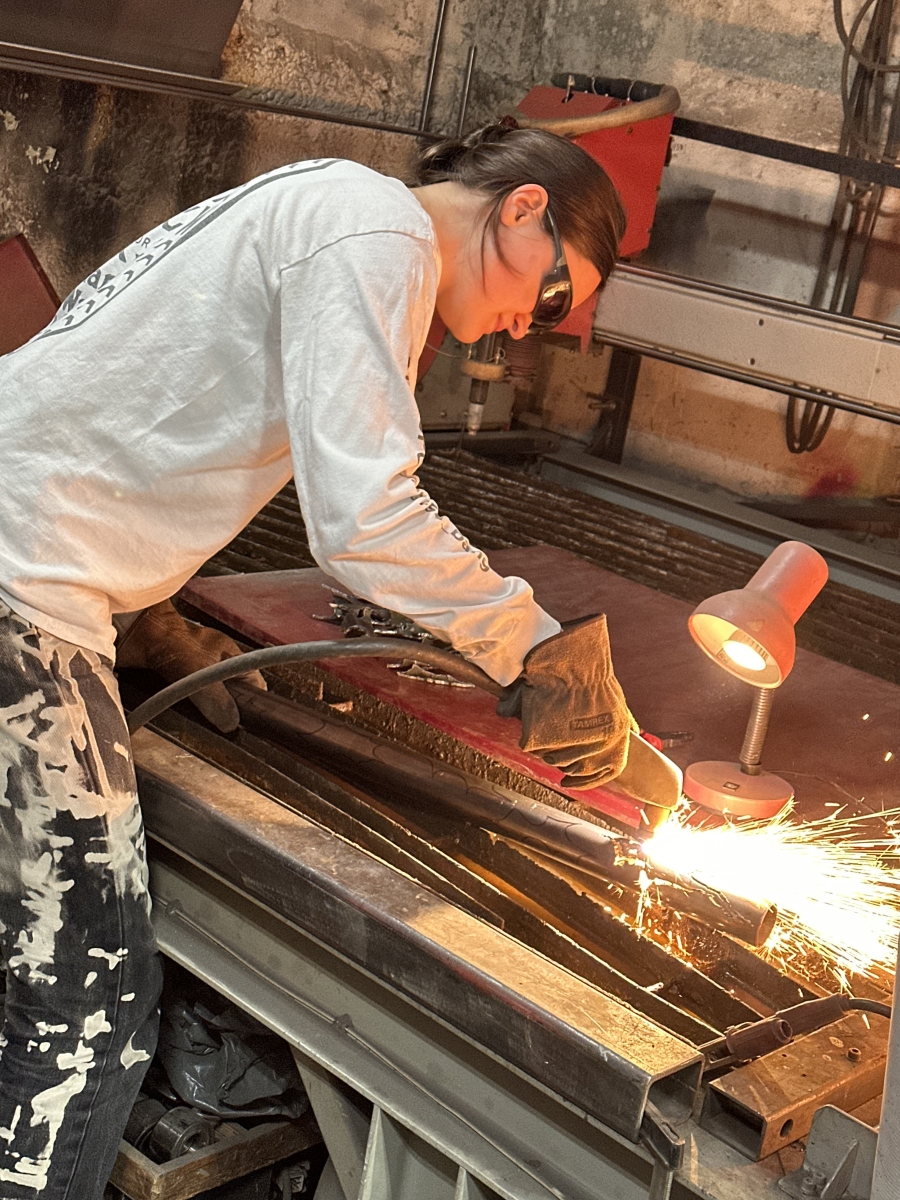
Karlina Mežecka plasma-cutting metallic patterns. Photo: Žanete Liekīte.

Glasremis studio in Panevezys. The process of merging ceramics and glass. Photo: Žanete Liekīte.
ŽL: Observing your work processes closely and recalling your hands-on approach, such as creating patterns in steel tubes with a plasma cutter, it becomes apparent that craftsmanship is at the heart of your practice. Yet, simultaneously, contextualisation looms just as large in your creative process. Can you expand on how these twin pillars function in your artistic practice?
KM: Maintaining a balance between these two elements is extremely important. The technical process through which I work consistently informs the narrative with which I’m working. Therefore, the craft and its meaning are inherently intertwined, and they cannot exist without one another. When I’m thinking about what I want to say, my mind naturally delves into the technical aspects of its execution. And when I’m working on something technically, I automatically start thinking about what it means in a broader context.
ŽL: You’ve previously said that the size of ceramics is directly influenced by the size of the kiln one has access to, which often results in the prevalence of smaller-size objects in this medium. Can you elaborate on how you navigate this limitation of scale in your artistic practice?
KM: Yes, it is always a looming obstacle. However, that’s when you start to think creatively. Because of it, there are two elements that play an important role in this show and are also significant in my practice. It’s the role of light (particularly when working with glass), and the role of the scenography or architecture of the exhibition. These two elements form an integral part of broadening the context and the perception of the pieces in the show. What I’m most interested in is how the pieces on view collaborate with the space, and enhance their presence in it.
In ‘Archive of Fragility’, the scenography represents a rigidity inherent to the collective Baltic environment, manifested through Soviet architecture. The steel panels, imposing a strong division of the space, hold window panes that have a similar pattern to the tiered rows of windows on the sides of Soviet-built apartment blocks. And this is the broader context I aim to address regarding culture and society, within which my works reside. In turn, everything I’ve crafted by hand from ceramics is tactile, sensual, and rather abstract. The coexistence, collaboration and clash between these elements is important to me.
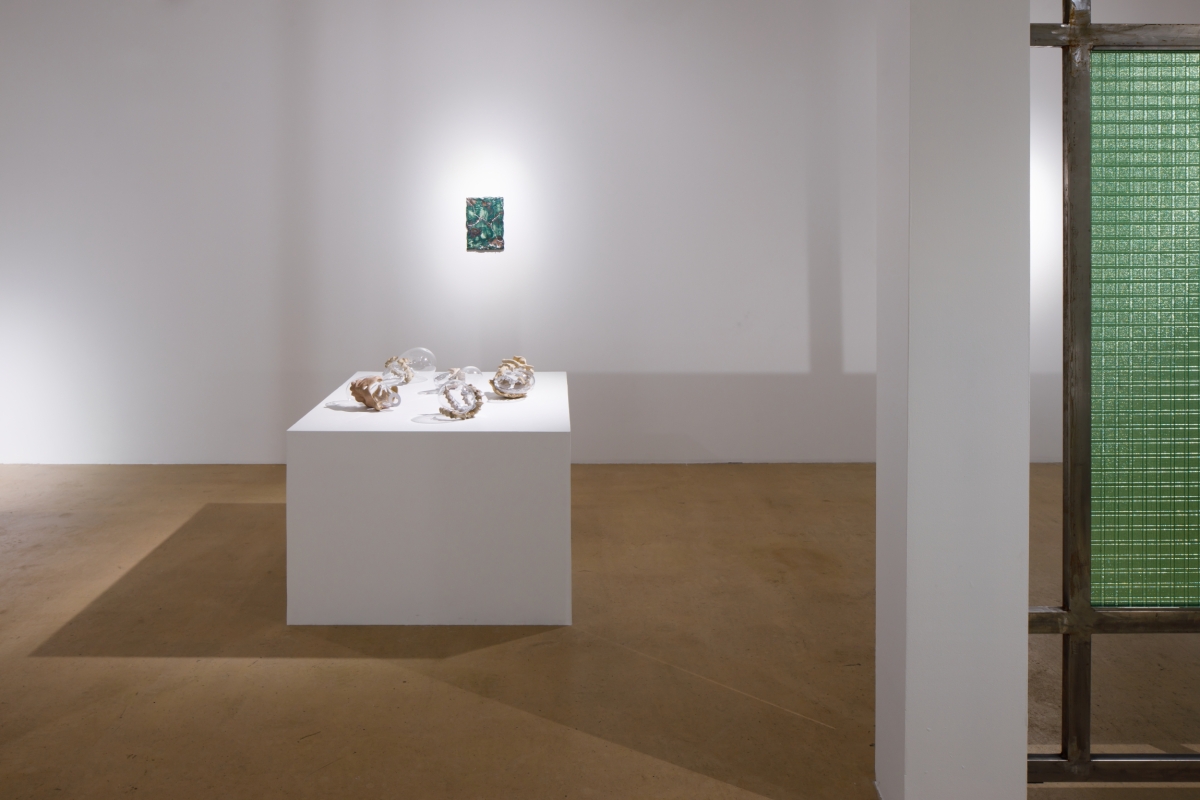
Karlīna Mežecka, Archive of Fragility, exhibition view, 2024. Kim Contemporary Art Centre, Riga. Curated by Žanete Liekīte. Photo: Ansis Starks.
ŽL: At the heart of our exhibition lies the concept of fragility, sparked by your ‘impossible’ technique involving the fusion of glass and ceramics. Despite discouragement from experts in London and in Līvāni, who claimed it couldn’t be done, you persisted with the union of these incredibly delicate materials. Can you talk us through the journey of that process, and what initially led you to explore it?
KM: I can honestly say, in many moments along the way, I really thought I needed to let it go and just do something else (laughs). When you’re engaged in a process during which industry professionals tell you straight out that it’s a lost cause, that it won’t work, just stop it, it messes with your head.
I began this journey during my MA in London. Honestly, it was just an epiphany, and I really wanted to try it. It was a pivotal moment when one of my tutors hinted at a particular clay body to work with. The first try (of many more to come) was unsuccessful, the ceramics broke from the thermal shock of glass blowing. But just seeing how the two materials complemented each other, how the glass had taken on the form of the ceramic sculpture, was enough to make me realise that this was it. It was love at first sight.
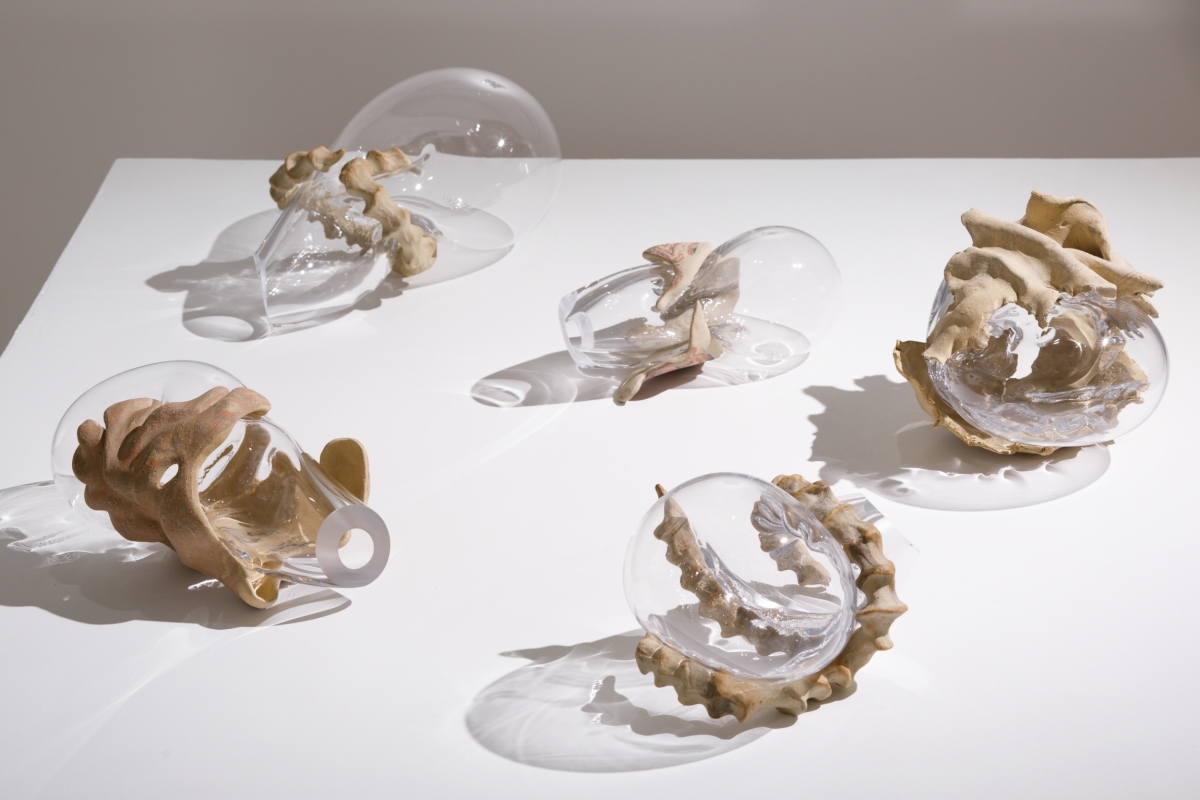
Karlīna Mežecka, Archive of Fragility, 2024, exhibition view, Kim? Contemporary Art Centre, Riga. Curated by Žanete Liekīte. Photo: Ansis Starks.

Karlīna Mežecka, Grip I, 2024. Ceramics, glass. Photo: Ansis Starks.
ŽL: Might it be that this wild idea sprung from the programme Ceramics and Glass? I mean, if they’re both in the name, they’ve got to collaborate, right (laughs)?
KM: Oh, for sure (laughs).
It’s funny how in a clay body, you can find silica (glass) and traces of various metals. Yet when you want to combine ceramics with glass and metal, it’s incredibly difficult to do.
ŽL: I find your glazing game intriguing, the way you transform ceramic surfaces to resemble metallic finishes. Additionally, you’ve recently begun incorporating metal as a secondary material in your work. Have you traced the thought process behind this fusion of materials?
KM: This game has been around for a while. And my personal fascination with a certain aspect of it has only grown over time.
If we take a look at the historical origins of alchemy, it’s somewhat similar: people sought to create gold out of nothing. How can one get endless wealth and gold from mud! That’s the gist of it. And if we look at gold lustre ceramics, they did quite well. They couldn’t physically recreate gold, but they certainly succeeded in replicating its surface qualities. This is just something I’ve found quite fascinating. It’s an interesting play with value and meaning.
I’ve spent a lot of time toying with replicating metallic surfaces, but I’m also interested in emulating other materialities, or working on ways to portray the corporeal in ceramics.

Karlīna Mežecka, Skin Topography, 2024. Ceramics, glaze. Photo: Ansis Starks.
ŽL: This part of human representation is particularly exciting. Metaphorically, the shapes and cracks of your abstract objects resonate with bodily mechanics, impulses, and the ‘imprints of experience’ etched into the skin.
KM: This notion has existed in my practice for a while. Corporeality and dynamism (in their composition), things which are inherent in the living, are crucial aspects I aim to capture in my work. After all, ceramics, like all fine arts, can often be quite static. There’s a focus on materials, on singular forms. I want to push those boundaries a bit, infusing pieces with a sense of vitality, playing God a little, maybe giving them a little soul (smiles).
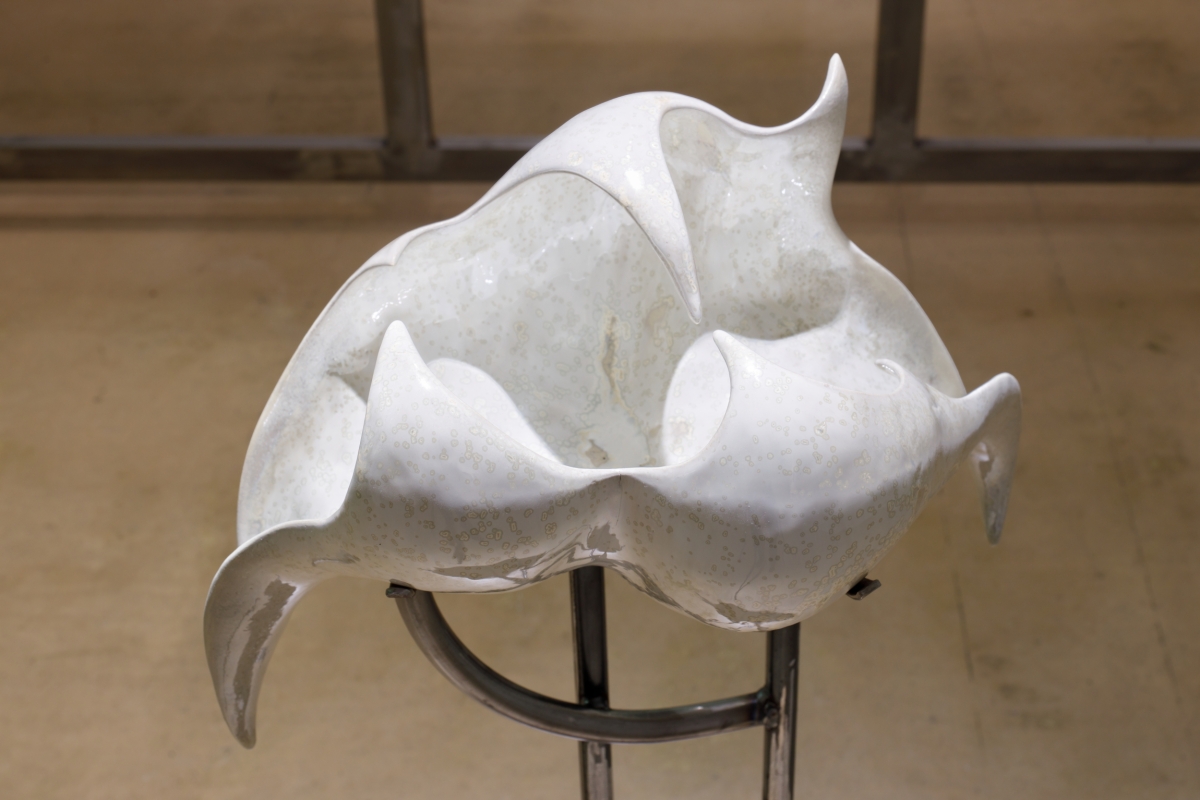
Karlīna Mežecka, Cradling Wail, 2024. Ceramics, glaze, steel. Photo: Ansis Starks.
ŽL: I vividly remember you explaining to your friends why certain materials represent the human body, by using a porcelain bowl in front of a lamp. They allow light to pass through, just like human skin.
KM: The porcelain episode was a significant revelation in my practice. The essence of this idea stems from ancient civilisations using marble for sculpture, as it shares a similar light translucency to human flesh. Similarly, being made from minerals, porcelain also has this material resemblance. It’s this unity within the spectrum of materials that gives it a sense of familiarity. The first time I heard about it, I was baffled, and realised from that moment on my life wouldn’t be the same (laughs).
Although I didn’t use porcelain in this exhibition, the material relationship with light has always been very important to me. In addition to light, I’ve always been captivated by the play of shadows and reflections. I think these elements contribute to the spatial experience of a show. These aspects manifest uniquely within the specific space and environment where the works are exhibited.
ŽL: Continuing our discussion on space, the French philosopher Gaston Bachelard’s Poetics of Space weaves together the connection between architecture, the body, and the spirit in our exhibition. How do you integrate insights from this theory into your artistic practice?
In line with what I mentioned about architecture, Gaston Bachelard in The Poetics of Space conveys beautifully how individuals perceive space, and their emotional connection with it. This concept serves as one of the main guiding principles for me in the context of the exhibition. While I aim to generalise the space, it remains rooted in the concrete reality of my origins in Riga and the Baltic. The feeling that I sought to evoke on entering the exhibition space is the interplay and rigidity of structure, illuminated by light and reflected off these structures. It’s about how light interacts with and permeates the works. That’s the poetics of space I aimed to achieve.

Karlīna Mežecka, Archive of Fragility, exhibition view, 2024. Kim Contemporary Art Centre, Riga. Curated by Žanete Liekīte. Photo: Ansis Starks.
ŽL: As you have just mentioned, our exhibition focuses more on collective patterns rather than a specific space or individual. However, could you perhaps share some hints where the personal is hidden in your works?
KM: My childhood was dominated by urban landscapes rather than by nature, although I spent time playing among the pines in the countryside and such. It’s kind of obvious why people who become attached to a specific landscape are likely to favour nature. This aspect plays a significant role in the exhibition as well, which is why you’ll notice a prevalence of green (laughs). I also have a personal affinity with the colour green, and at one point, I realised that everything in the exhibition is predominantly green. This connection is also tied to the lush greenery of the Baltic forests.
I remember as a child having this realisation: everyone seems to love nature, but why do I love living in the city? Within cities lies a phenomenon that’s a lot less common in nature: the reflection of light that occurs from the glass facades of high-rise buildings. These reflections cast a beautiful play of light and shadow on the streets and facades opposite. This was something I wanted to capture in the exhibition.
ŽL: Expanding on the discussion of landscape, within ‘Archive of Fragility’ there are pieces on the walls affectionately dubbed ‘landscapes’. We’ve chosen to interpret them as exhibition windows, or perhaps as a bird’s-eye view of the site’s topography. Before this interpretation, how did you envision these ceramic works resembling paintings?
KM: The first iteration of these landscapes was made during my time at the RCA. The work was entitled Free Flow, and it essentially depicted a specific landscape, the riverbed of the Thames. There was an extremely beautiful view of the river near the college, the historical presence of London would often be exposed with the tides coming in and going out.
I vividly recall standing by the riverbank, and there was this moment of another epiphany. The light hit just right, revealing the exposed riverbed after the tide receded, with an anchor chain sprawling along the bank. The metal formed such a beautiful pattern, glistening in the light in a deep, bright silvery hue. I was completely taken by that brief moment, and I decided to recreate it.

Karlīna Mežecka, Free Flow, 2022. Ceramics, glaze, tin, glass.
ŽL: The poetic cityscape of London inspired you to create paintings in ceramics.
KM: Technically, yes. And these works also offer a broad canvas for experimentation, because they can be endlessly varied. There’s a piece in the show that has a distinctly painterly quality to its surface. Another is dark and metallic, resembling a stormy sky illuminated by lightning. That’s the real beauty of it. As diverse as the landscape can be, I can capture its qualities through various ceramic techniques.

Karlīna Mežecka, Body Electric, 2024. Ceramics, glaze, tin. Photo: Ansis Starks.
ŽL: Exploring the evolution of another body of work, the piece Cradling Wail takes centre stage in the new exhibition. In terms of its development, it stems from your graduation show piece Wail, which later featured in our group exhibition ‘Synchronities’. Recalling the original association of Wail with the depths of the ocean and the unconscious, what significance does ‘baby wail’ hold for you?
KM: I managed to create this piece quite intuitively. Right from the start, I envisioned this smaller version as being notably rounder, plumper, and more vital. While working on the previous piece, I had this notion of portraying an alien-like figure. Here, it also has an otherworldly quality to it, as it lacks a reference to a distinguishable shape. What I aimed to achieve with this piece aligns with my earlier thoughts about infusing works with a soul and a dynamic composition.

Karlina Mežecka, Wail, 2022. Ceramics, metal paint, chains. Group exhibition Synchronicities, LOW off-site projects, Riga, Latvia. Curated by Žanete Liekīte. Photo: Filips Smits.
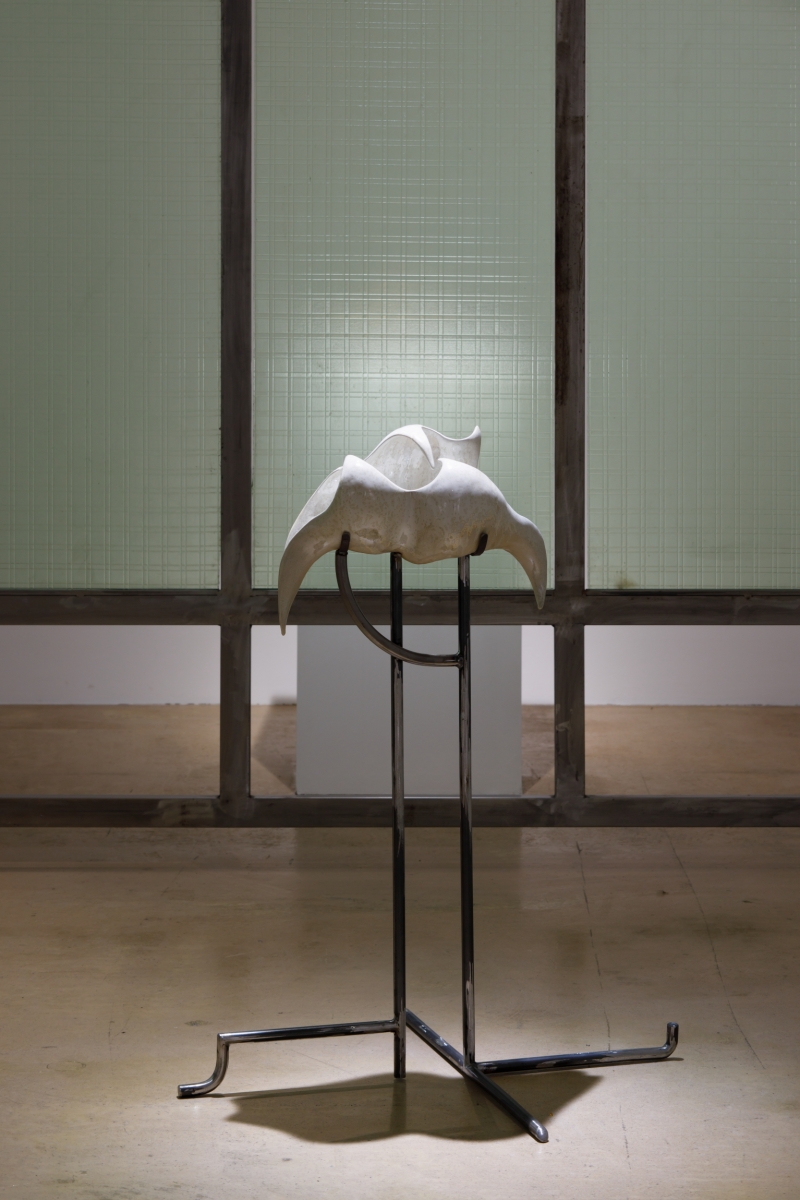
Karlīna Mežecka, Cradling Wail, 2024. Ceramics, glaze, steel. Photo: Ansis Starks.
ŽL: I believe you’ve got into your stride here. Recalling the opening, visitors mentioned that your works appear like a movement captured still, a frozen moment … All right, to wrap up ‘Archive of Fragility’, I have one last question! Now that the exhibition has opened and we’ve had some time for reflection, what exactly do you think we archived here?
KM: I’ve pondered this question quite a bit, trying to pin the essence of what an archive truly represents. Usually, when thinking of an archive, an image of a vast collection of dusty papers and photographs and artefacts comes to mind, documenting a specific time, place and people. But I do think that many different things can serve as this documentation, including materiality. The show serves as an archive not of precise documents, but of various materials that convey profound emotions and experiences. In a way, I think this diversity of materials, all coming together to explore the depths of the human condition, is what defines the essence of our archive.
ŽL: I suppose that’s why we emphasise the poetics, and refer to it as a poetic archive. Despite its abstract nature, it holds a deeply personal essence (smiles).
KM: Yes (smiles).
